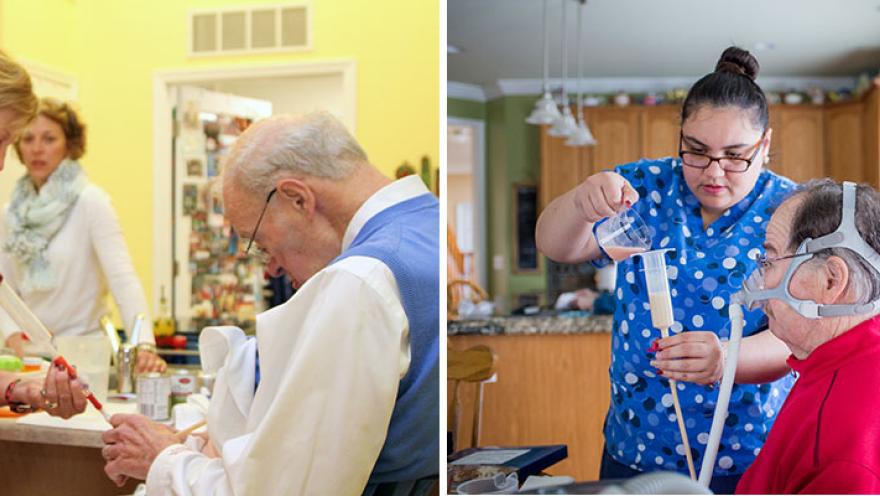Learning that you should consider a feeding tube can be overwhelming. It is a lot to take in, particularly in combination with the many medical issues that come with an ALS diagnosis. It is common for patients to be hesitant about it, but often, once they see the benefits of tube feeding, they often regret not making the decision sooner.
As part of the ALS care planning process, it is important for patients to discuss options with their multidisciplinary care team, weighing the pros and cons, and understanding how their decision will affect their life while they are capable of making these decisions with the least amount of stress and difficulty.
In recognition of Feeding Tube Awareness Week, we asked one of our chapter experts in Care Services, Megan Frisk, care services coordinator for The ALS Association Rocky Mountain Chapter and registered dietitian (RD), to share her thoughts and experiences she’s had with the many patients and families she works with every day.
What do you think is the most common misconception about feeding tubes?
Not being able to eat by mouth while receiving nutrition through their feeding tube. It is often safe to eat foods by mouth in conjunction to using a feeding tube. A speech therapist can determine the safety of swallowing foods or liquids by mouth and recommend a certain diet for safer intake if needed, for example, soft or pureed diet.
What are some of the benefits of getting a feeding tube for a person living with ALS?
A few of the benefits may be decreased fatigue, less anxiety around mealtime, fewer choking episodes, safer medication administration, and reducing or halting weight loss.
Is it important to decide whether to get a feeding tube early in your diagnosis? Early consideration is recommended throughout the disease progression and deciding to get a feeding tube is no exception. Time is needed to consider the multiple factors that can contribute to making the decision such as, significant weight loss, choking with swallowing, decreased oral intake, and/or respiratory status. Speaking with your physician about the decision can help determine if it is the right choice for you.
Are there different types of feeding tubes and/or feeding tube options?
There are several types of feeding tubes, nutritional options, and many ways of administering the nutrition.
Types of tubes that may be placed are gastrostomy tube (G-tube), percutaneous endoscopic gastrostomy (PEG) tube, and low-profile gastrostomy feeding tube or mic-key. The surgeon will decide which is most appropriate on an individual basis.
Nutrition can be administered through the tube using a continuous, cyclic, intermittent, or bolus (syringe) feeding. There are also several different premade formula options ranging from GI sensitive, high protein, or plant-based to name a few. Patients similarly have the option of blending their own formula out of whole foods.
The registered dietician or enteral nutrition specialist can help you determine which nutrition source and administration makes the most sense for your lifestyle and daily routine.
Once the decision is made, what is the process a patient must go through to get a feeding tube?
Typically, a physician and registered dietitian will provide more specific information about the procedure, help with scheduling, and provide pre/post-care instructions. The RD will visit with the patient to assess individual nutritional needs and provide a prescription for the tube feeding formula and/or supplies.
Is there training provided and if so, by who?
Yes, there should be training provided before and after the procedure by a skilled nurse or registered dietitian. A few of the settings where you may obtain training is within a multidisciplinary ALS clinic, at the hospital, and within the home from an enteral nutrition care company.
Is it difficult to provide enough nutrition through a feeding tube to keep an ALS patient healthy on a daily basis?
No, but I would highly recommend working closely with a registered dietitian to maintain the proper amount of intake through the feeding tube. Standard cartons of formula are fairly nutrient-dense, for example, one carton (240-250 milters) on average contains 400-500 calories and 16-20 grams of protein. On average they have found 40-50% of people living with ALS have an increased metabolism, in which case increasing intake through the feeding tube may be necessary to meet nutritional needs.
What feedback do you hear once a patient has made the decision and gone through the process of getting a feeding tube?
I often hear, “It’s pretty easy”, referring to administering the formula through the tube or “I feel less stress around eating.”
Administering the formula can be quite simple, but prior to having the procedure, it is best to speak with your care team about who, when, and how you or your caregiver plan to administer the nutrition. People living with ALS can often administer their own formula, but this does require a certain level of hands dexterity and arm mobility.
To learn more about tube feeding and living with ALS, visit our free resource library here.
Megan Frisk joined The ALS Association Rocky Mountain Chapter in July 2019 after spending 7 years working in 2 ALS clinics as a registered dietitian. She received her bachelor’s degree and Master of Science in Human and Community Nutrition from Southern Illinois University. She is passionate about supporting people living with ALS and their families and finding resources to improve the quality of life and longevity of all those she works with.


Join the conversation. Please comment below.